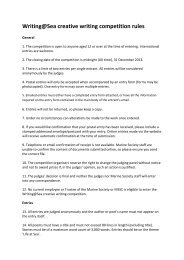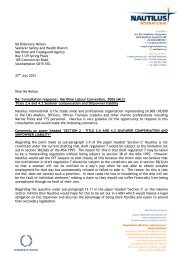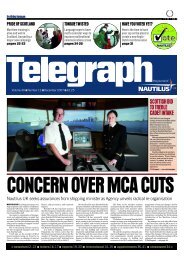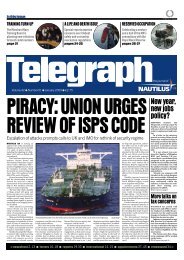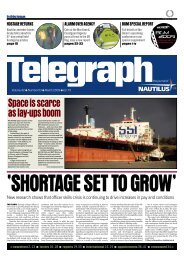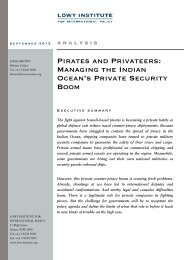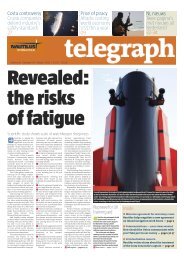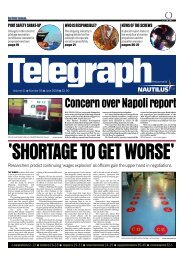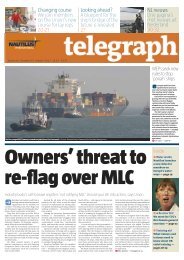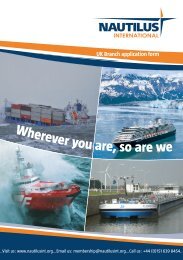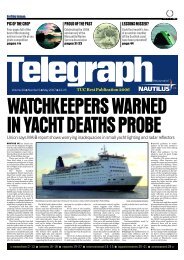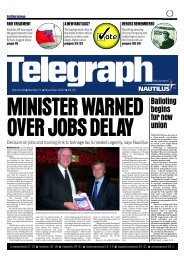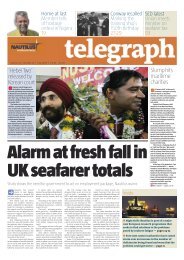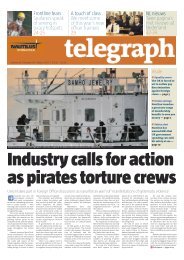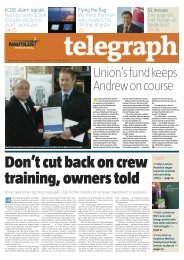NAUTILUS P01 NOVEMBER 2009.qxd - Nautilus International
NAUTILUS P01 NOVEMBER 2009.qxd - Nautilus International
NAUTILUS P01 NOVEMBER 2009.qxd - Nautilus International
You also want an ePaper? Increase the reach of your titles
YUMPU automatically turns print PDFs into web optimized ePapers that Google loves.
November 2009 | nautilusint.org | telegraph | 23<br />
WATER FREIGHT<br />
‘Time for<br />
more than<br />
lip service’<br />
The Commercial Boat Operators Association has<br />
echoed <strong>Nautilus</strong> concerns that the UK government has<br />
overlooked the role water freight could play in<br />
reducing carbon pollution.<br />
Commenting on the government strategy paper<br />
Low Carbon Transport — A Greener Future, the trade<br />
association for companies that carry freight on the<br />
UK’s inland and estuarial waterways warned that<br />
while rail gets serious mention in the white paper,<br />
water freight is largely ignored.<br />
The CBOA points to a 2006 report from the Tyndall<br />
Centre for Climate Change Research, which showed<br />
that moving freight by road produces 400% more<br />
carbon emissions than water transport.<br />
‘It is time the government did more than pay lip<br />
service to the part that water freight can play in<br />
reducing carbon emissions and cutting down road<br />
congestion,’ said chairman John Dodwell.<br />
In a special report on<br />
waterborne freight, MIKE<br />
GERBER looks at what the<br />
UK is doing to shift to the<br />
rivers and seas…<br />
Parliament saw the potential of water freight when the Dutch-built vessel Terra Marique passed by in 2004 P icture: Robert Wynn & Sons<br />
UK needs to make<br />
water work for a<br />
greener future...<br />
w<br />
One million tonnes of waterborne freight<br />
sails by the Houses of Parliament on barges<br />
each year — a reminder to the government<br />
of pledges to encourage far greater use of Britain’s<br />
inland and coastal waterways to move cargo around<br />
the country.<br />
But compared with many other EU member states<br />
— not least the Netherlands — the UK has been slow<br />
to tap water freights massive potential to ease the<br />
burden on our congested and polluted roads.<br />
Despite the existence of the freight facilities grant<br />
to help support the shift of freight from the roads,<br />
official statistics for 1997 to 2007 show a decline in<br />
domestic waterborne freight from 141.8 to 125.9m<br />
tonnes, largely explained by the end of sea-dumping<br />
of sewage sludge, the loss of formerly significant coal<br />
traffic and some grant-aided projects not reaching<br />
targets.<br />
‘Water transport is disadvantaged by the present<br />
funding arrangements and government needs to<br />
deal with this as an urgent priority,’ Dr Hilling insists.<br />
‘The criteria for the award of freight facility grants<br />
must be far more flexible and must take into account<br />
that investment in shipping is long term — many of<br />
our barges are 30 years [old] plus — and requires<br />
guarantees about waterway maintenance and market<br />
conditions.’<br />
Although IWA primarily champions inland waterways,<br />
Dr Hilling points out: ‘We always argued that it<br />
makes sense to view the UK’s domestic waterways as<br />
an integrated functional system embracing inland,<br />
coastal and shortsea shipping. We have a natural<br />
coastal ring road, we have radial routes provided by<br />
the inland waterways and outward links to overseas<br />
places. I became involved with the IWFG because of<br />
my interest and publications on barge-carrier systems<br />
— the idea of a maritime link between waterway<br />
systems.’<br />
The Dutch-built vessel Terra Marique — operated<br />
by Robert Wynn & Sons, specialists in the movement<br />
of ‘abnormal indivisible loads’ (AILs) — is a case in<br />
point.<br />
Developed in association with Dutch shipbuilders<br />
Damen with the aid of a £8.5m DfT grant and<br />
described as a multi-purpose pontoon with seagoing<br />
capability, it can transport loads of up to 1,200<br />
tonnes along the UK coast and waterways that<br />
include the Manchester Ship Canal and tidal<br />
stretches of the Thames and Trent.<br />
Terra Marique can transfer loads along the UK<br />
coast to ports such at the Tees, from where specialist<br />
heavylift vessels sail worldwide, and also make<br />
shortsea crossings to Belfast and Glasgow. It is also<br />
designed to work in combination with Wynns’<br />
smaller vessel, Inland Navigator, which transports<br />
AILs of up to 44 tonnes by water to and from points<br />
many miles inland.<br />
As the company points out: ‘Together the two vessels<br />
can transport huge pieces of cargo many hundreds<br />
of miles around the UK coast and to the ports<br />
and inland waterway systems of NW Europe.’ Regular<br />
ports of call include Rotterdam and Antwerp.<br />
Dr Hilling, alongside his IWA role, is UK vicepresent<br />
of the Berlin-based European River Sea<br />
Transport Union — so is well positioned to comment<br />
from the European vantage point. ‘Clearly the scale<br />
of operations is very different in mainland Europe;<br />
their rivers tend to be much larger and longer and<br />
their canals built to less restrictive dimensions than<br />
ours. They also have the advantage that much industrial<br />
activity is located close to waterways and the<br />
overall distances favour waterborne freight.<br />
‘However, I think that they have adopted a far<br />
more positive approach to development of waterways<br />
and have invested in this mode — the recent<br />
completion of the Magdeburg “cross” is a case in<br />
point.’ This is the water bridge that now connects Berlin’s<br />
inland harbour network with the ports along the<br />
Rhine.<br />
‘In this country, the amount of investment<br />
required to upgrade the waterways at selected points<br />
would be peanuts compared with what we spend on<br />
roads but would probably pay dividends on certain<br />
strategic waterways,’ Dr Hilling points out.<br />
When British Waterways (BW) upgraded the Sheffield<br />
& South Yorks Navigation, the bulk of the capital<br />
had to be borrowed by BW at market rates — not the<br />
way we invest in roads.<br />
‘The attitude in this country is now more positive,<br />
but our mainland neighbours all had water freight<br />
promotion centres some years before we got around<br />
to it. They have tended to treat waterways like other<br />
transport infrastructure and government foots the<br />
bill,’ Dr Hilling explains.<br />
When London was awarded the 2012 Olympics,<br />
the Olympic Delivery Authority set itself a target of<br />
50% of site traffic to be handled by sustainable transport,<br />
and now claims that 57% is in fact being handled<br />
by rail. A laudable achievement — yet as Dr Hilling<br />
observes: ‘Water has yet to really get going, although<br />
the Olympic Park is surrounded by waterways.’<br />
A new lock allowing bigger vessels to access the<br />
site opened in June, yet traffic has been moving to the<br />
development for over two years. ‘The whole project<br />
took too long, there was no sense of urgency and it<br />
seems again that water transport was the neglected<br />
Hull terminal transfers<br />
The shortsea shipping movement was given a boost last month with the opening of a new all-weather terminal at<br />
the port of Hull. The first customer was the Netherlands-flagged general cargoship Priscilla (pictured), carrying a<br />
shipment for agricultural firm Helm Fertilizer.<br />
Vessels of up to 13.5m air draft can be accommodated within the terminal, which allows for an undercover<br />
rail-freight connection. The 10,000 sq m cargo-handling facility was formerly the Hull Steel Terminal, but in its new,<br />
fully-enclosed form can provide storage for dry bulk goods such as paper and agricultural products.<br />
Despite heavy rain outside, the Priscilla discharged 2,750 tonnes of bagged ammonium nitrate in completely dry<br />
conditions. ABP Hull & Goole deputy port manager Mark Sellers noted that the undercover transfer had cut out the<br />
threat of weather-related delays, and Helm Fertilizer MD Mark Wood pronounced himself highly satisfied with the<br />
management of his cargo: ‘If I was a farmer, I would like to think that all fertilizer was handled this way.’<br />
‘<strong>Nautilus</strong> <strong>International</strong> welcomes the opening of this terminal,’ commented general secretary Mark Dickinson. ‘If<br />
more ports had good ship-to-rail transfer facilities, it would enable an increase in the use of environmentally-friendly<br />
shortsea shipping — cutting CO 2 emissions and reducing congestion on the highways by offering an efficient<br />
alternative to long-distance road freight.’<br />
g As the Telegraph went to press, Associated British Ports confirmed its commitment to environmentally friendly<br />
freight with a successful emissions-cutting initiative at its Hams Hall rail freight terminal near Birmingham. This<br />
terminal, which handles containers from numerous rail-equipped UK ports, has just won an Environmental<br />
Innovation Award at the 2009 Rail Freight Group Awards. The award is for reducing fuel consumption and CO 2<br />
emissions in the ‘reach stackers’ which lift containers on and off trains.<br />
mode,’ Dr Hilling complains.<br />
However, all is not yet lost, he adds, as much material<br />
has still to be imported to the site and much could<br />
be imported by way of the wharves on the Thames<br />
— aggregates, paving material, other construction<br />
material, pipework, equipment and abnormal loads<br />
being the most obvious. Indeed, this could be a demonstration<br />
of the effective integration of inland,<br />
coastal and shortsea shipping — and BW and Transport<br />
for London have appointed a sustainable transport<br />
manager (ex-merchant master mariner Kim<br />
Milnes) to help move things along.<br />
Water transport may yet get to play its full part in<br />
helping alleviate the freight traffic suffocating Britain’s<br />
roads, following the DfT announcement in July<br />
of highly promising developments. The European<br />
Commission has approved state aid for the UK’s proposed<br />
modal shift revenue support (MSRS) scheme,<br />
and also for a modified waterborne state grant. MSRS<br />
will replace the present rail environmental benefit<br />
procurement scheme — REPS — from April next year<br />
and operate till 31 March 2015. The scheme will operate<br />
in two parts: the modal shift to inland waters and<br />
most non-containerised rail applications will be<br />
handled through the MSRS (Bulk & Waterways), while<br />
applications for most modal shifts for rail container<br />
traffic will be handled through MSRS (Intermodal).<br />
Funding will be awarded to successful inland waterways<br />
schemes from 20 September 2009.<br />
In ancient Greece, Aquarius was the mythological<br />
water bearer. In modern Britain — if DfT gives the<br />
bearers of water freight the backing they merit —<br />
might we be about to see the dawning of the age of<br />
Aquarius?



